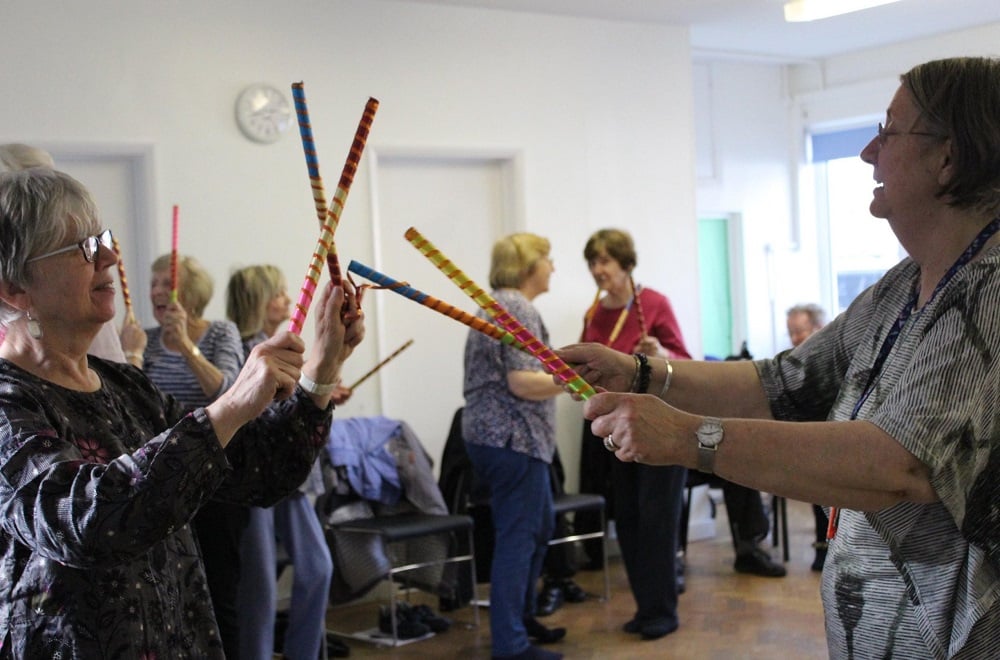
Dance Well at Harefield Library
Photo: Akademi 2017
Dancing to South Asian rhythms
Older adults living with chronic health conditions are improving their physical and mental wellbeing through the joy of South Asian dance, writes Claire Farmer.
Dance Well is Akademi’s learning and participation project for older adults living with chronic health conditions and those with little or no access to physical activity. Dance Well workshops, inspired by South Asian dance styles such as Bharatanatyam, Kathak, Odissi and Bollywood, began in January 2016, taking place in community centres, care homes, hospitals and dementia day centres.
There is a preconception that dance requires a large amount of space to have an impact, but we can provide creative movement at a patient’s bedside
To date we have delivered over 200 workshops to more than 900 older adults living with a range of health conditions. I manage the project alongside our project assistant, Pia Zicchi, who attends each workshop, greeting participants, gathering feedback and supporting the dance artist. The work itself is delivered by our core pool of learning and participation dance artists, many of whom also perform in our productions. When the sessions are completed the participants take home a booklet of South Asian dance-inspired exercises.
Participant autonomy
Akademi’s approach to working with older adults is to allow them autonomy over the movement and the direction of the class. This works particularly well with the storytelling element of South Asian dance genres. Participants learn some of the many traditional mudras (hand gestures), and can then use these to create their own stories or learn stories that already exist in literature.
The use of rhythm through clapping, dandiya sticks and ghungroos (ankle bells) is also very popular among participants. Learning rhythms such as Kathak bols brings the group together in unison, and also provides additional sensory feedback for those with limited mobility. We have seen time and time again that the participants who are not engaging in the activity suddenly begin to participate when rhythm work begins, even if this is a small movement of the fingers or toes to begin with.
We allow participants to develop the content of classes, avoiding a didactic approach to teaching and sometimes changing the plan completely according to the needs and motivations of the participants that day. This is especially the case while working in hospital wards, when you may not know in advance who you will see and how they might feel.
An integral part of our work is to include visitors, relatives, carers and staff in the activity, so the dancing becomes a shared experience, altering the relationship between, for example, a nurse and patient, allowing them to build a rapport and a different kind of connection. Anyone visiting a session is encouraged to join in, sharing in the experience of learning new skills and exploring their creativity in a friendly and safe space.
Work in hospitals
Over the past year, our work in hospitals has expanded significantly, reaching across five NHS foundation trusts. Our dance artists provide performances and participatory work in public spaces in the hospitals, as well as within the bays.
This is a particularly important area of work as we are able to reach older adults who ordinarily might not have access to the arts or to physical activity due to limited physical or cognitive ability.
Reaching an initial agreement to enter a hospital with dancers – and particularly to enter the wards – can be difficult. There is a preconception that dance requires a large amount of space to have an impact, but we can provide creative movement at a patient’s bedside. Once clinical staff see and experience the dancers’ impact in the ward and the positive change in atmosphere, they are often at the door watching or joining in.
Artist training
We are committed to a high quality of delivery and artistic content in our workshops, and therefore appoint professional South Asian dance artists to deliver the sessions. Participant safety is also a priority, and all artists receive specialist training to prepare them for teaching in community and health settings.
They also receive training on chronic health conditions, including chronic obstructive pulmonary disease, heart disease and dementia. Since 2016 we have offered a comprehensive training package that includes practical and theoretical training days as well as shadowing opportunities with peers.
Dance for health is a rapidly developing field, and it is important to share our experiences, resources and training with other practitioners. For this reason, we have produced free digital resources for dance practitioners on delivering South Asian dance with older adults, as well as a library of 24 educational videos available online to help artists develop a toolbox of activities.
Systematic expansion
Even though South Asian dance has been used previously in community and health settings, this is the first time it has been implemented in such a large and systematic way. The length and scope of Dance Well has enabled us to record and analyse the findings and long-term benefits of South Asian dance on physical and mental wellbeing. We hope to expand this work over coming years into more hospitals and community organisations so that many more older adults can enjoy the benefits of South Asian dance.
Claire Farmer is Dance Well Project Officer at Akademi South Asian Dance UK, Joint Manager of the National Institute of Dance Medicine and Science, and Associate Lecturer at Roehampton University.
akademi.co.uk/
Tw @Akademi

Join the Discussion
You must be logged in to post a comment.